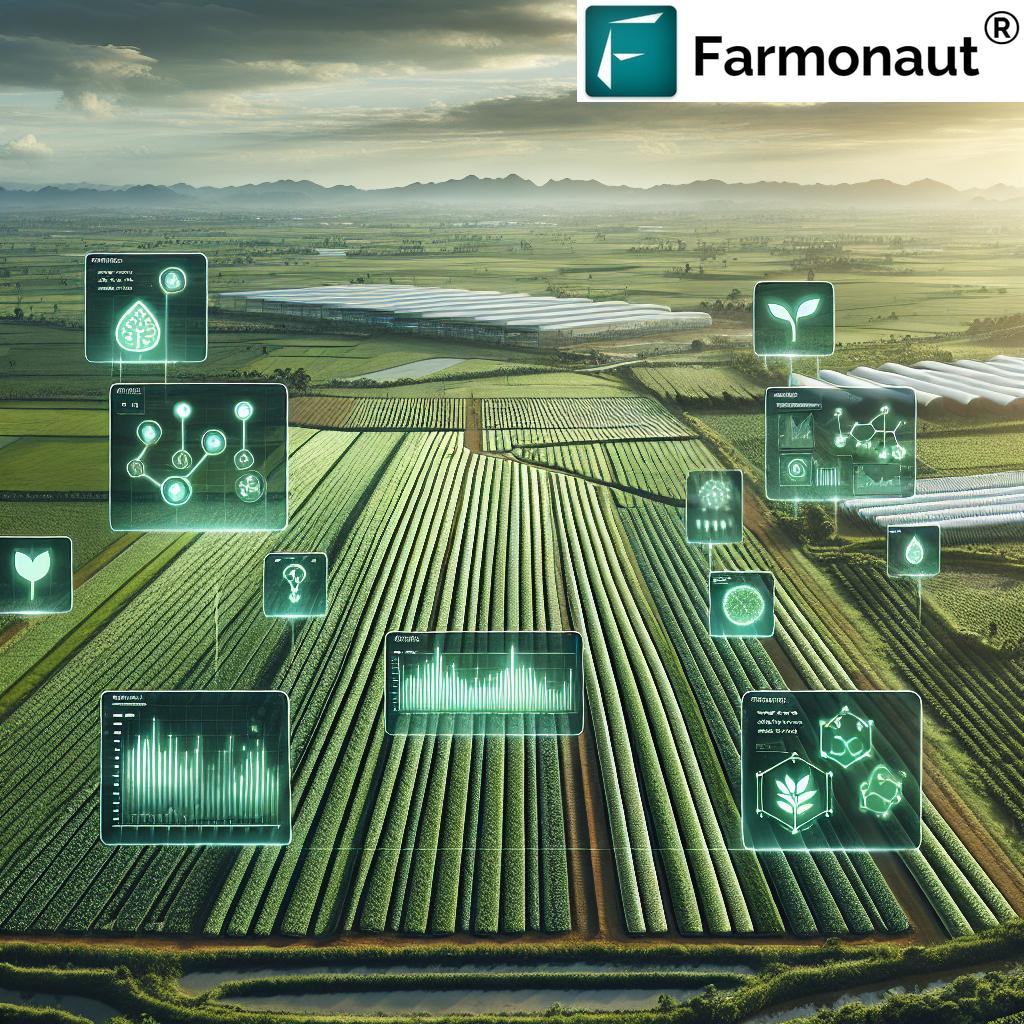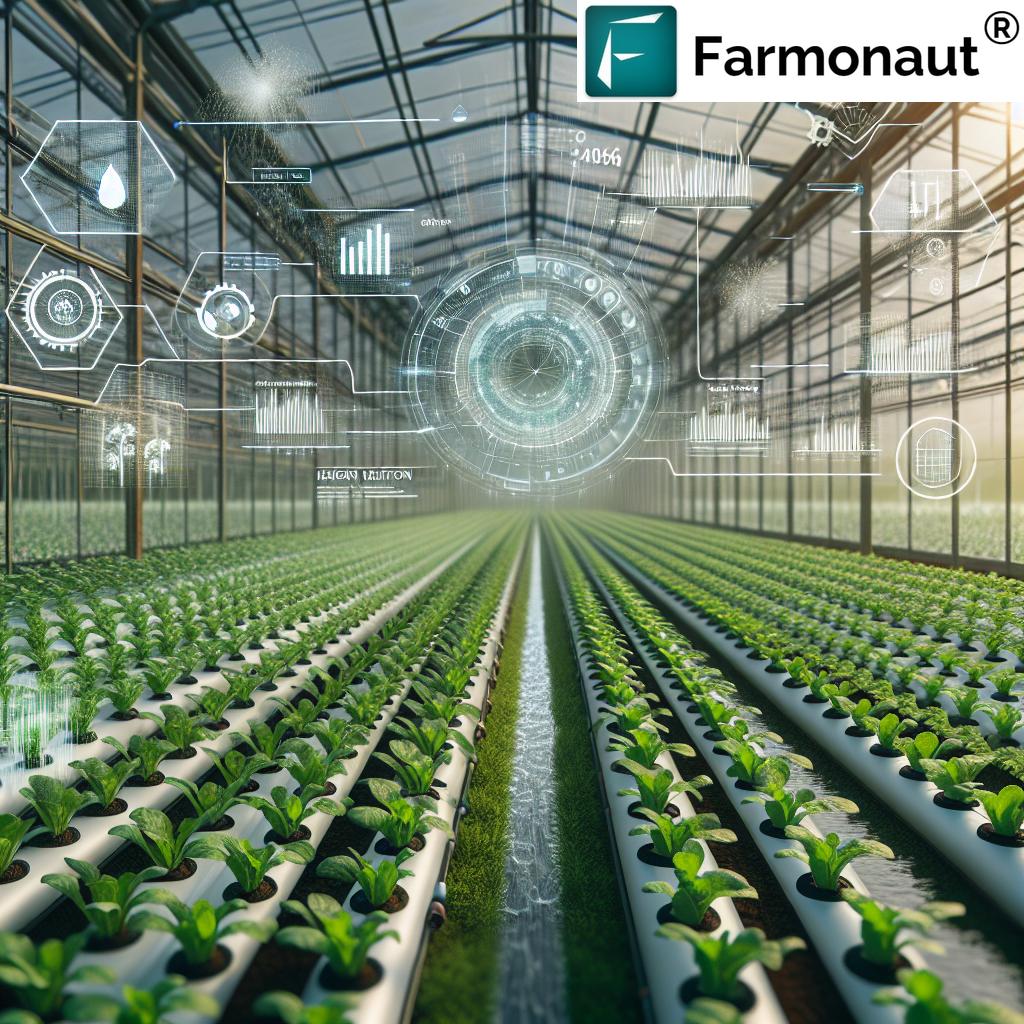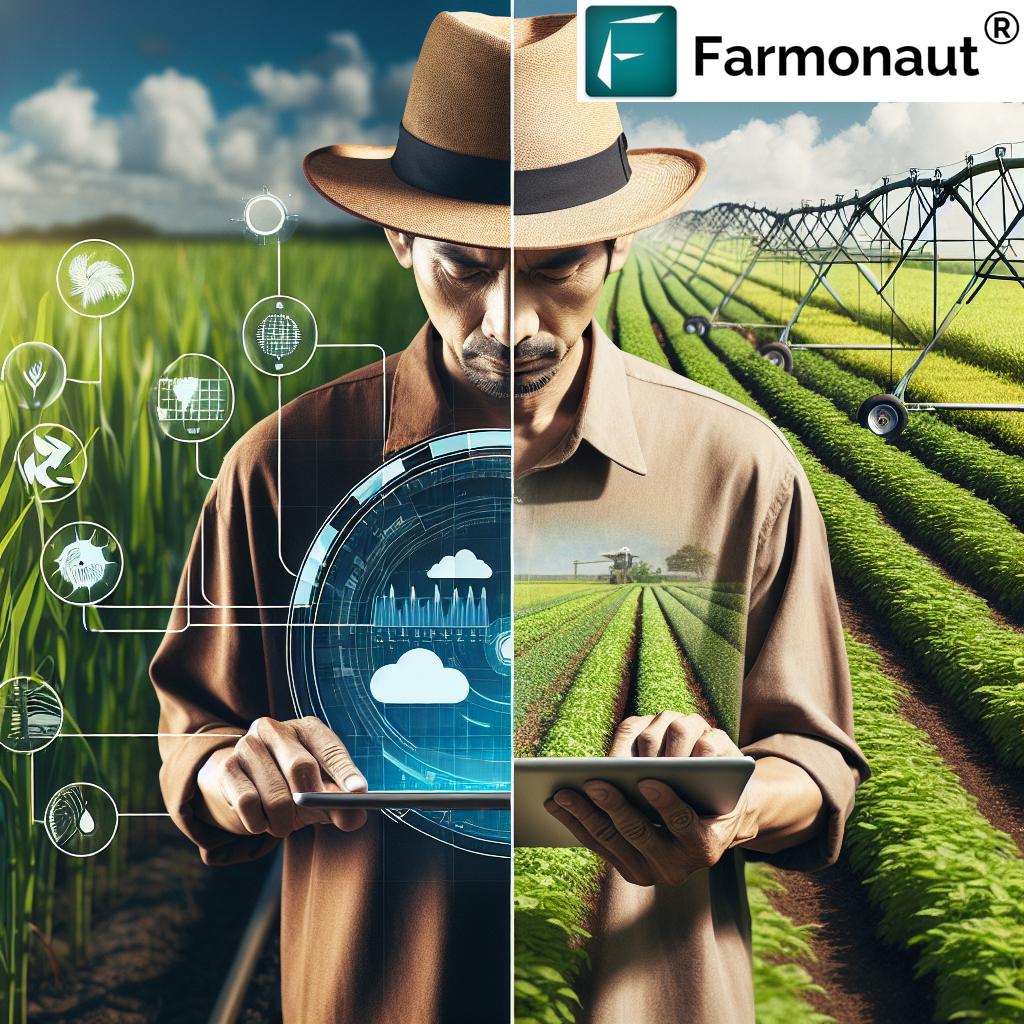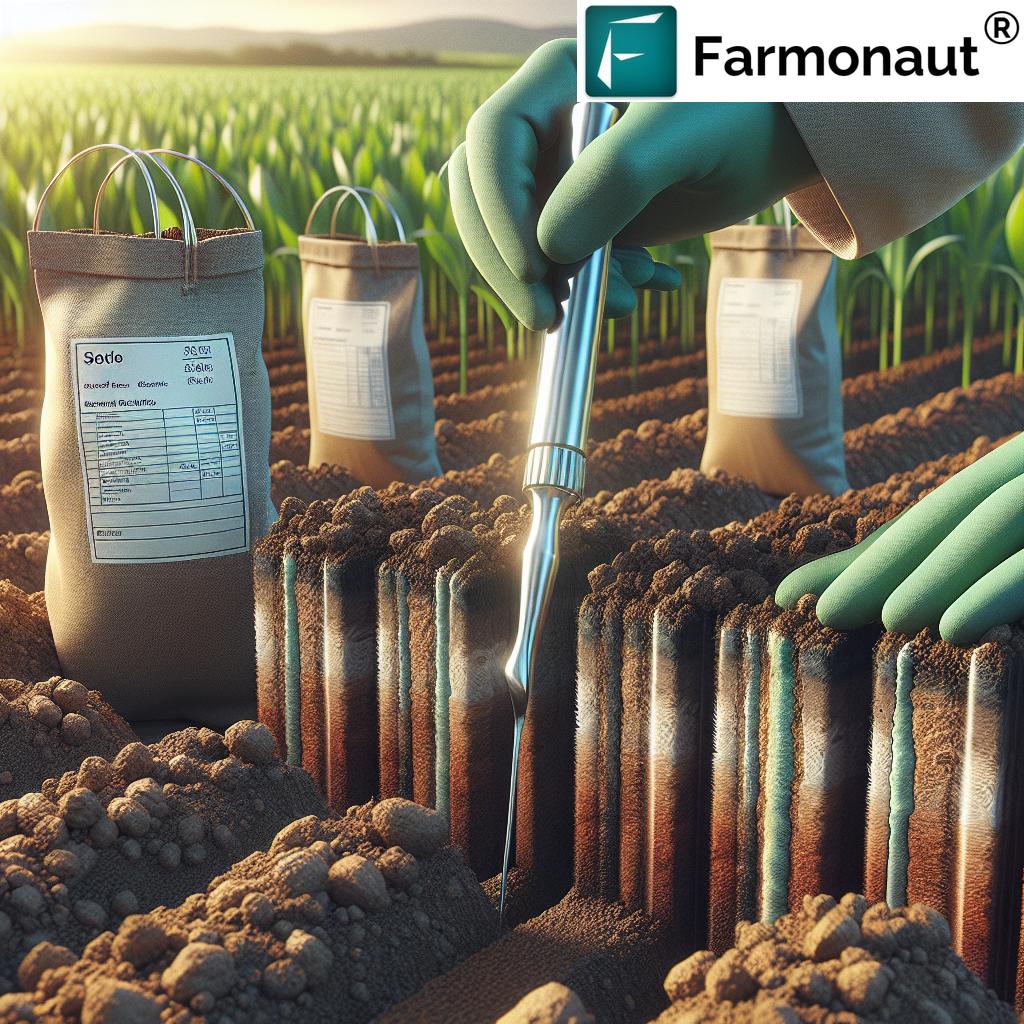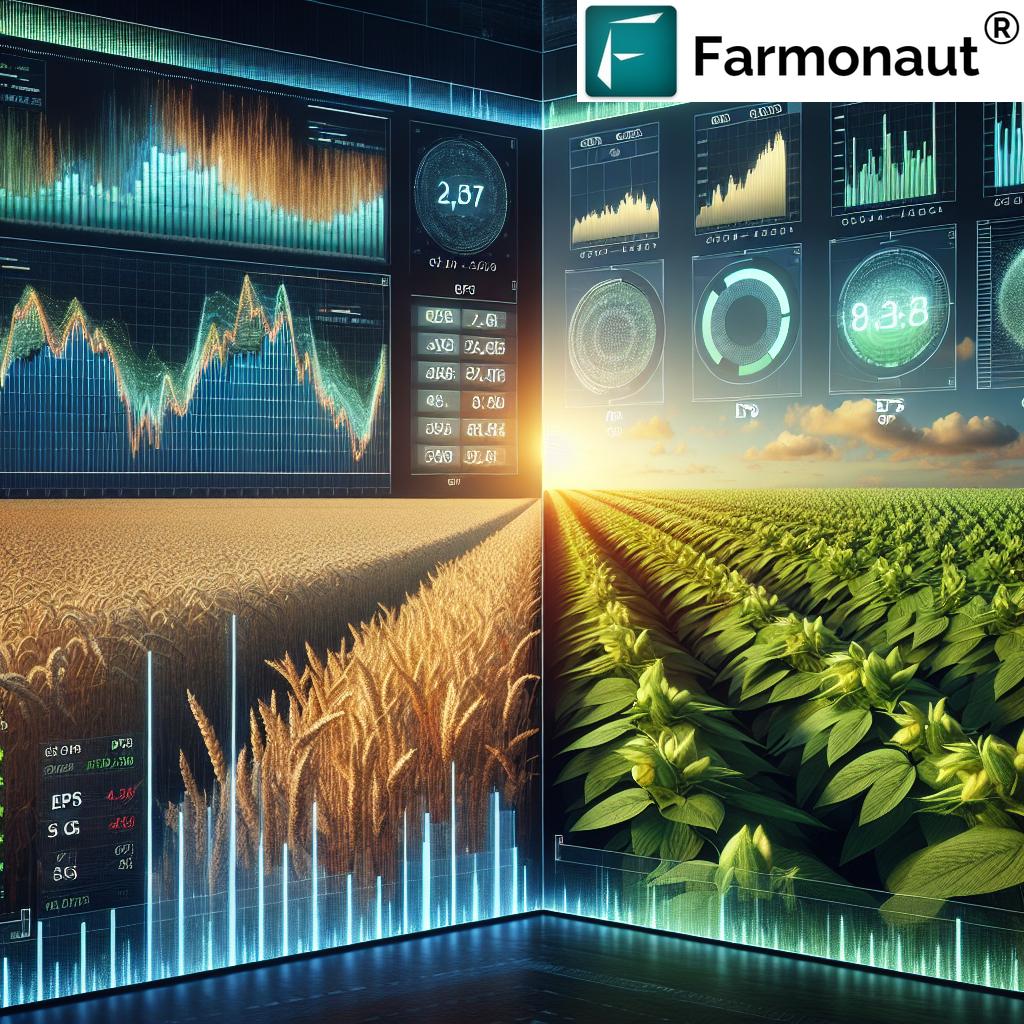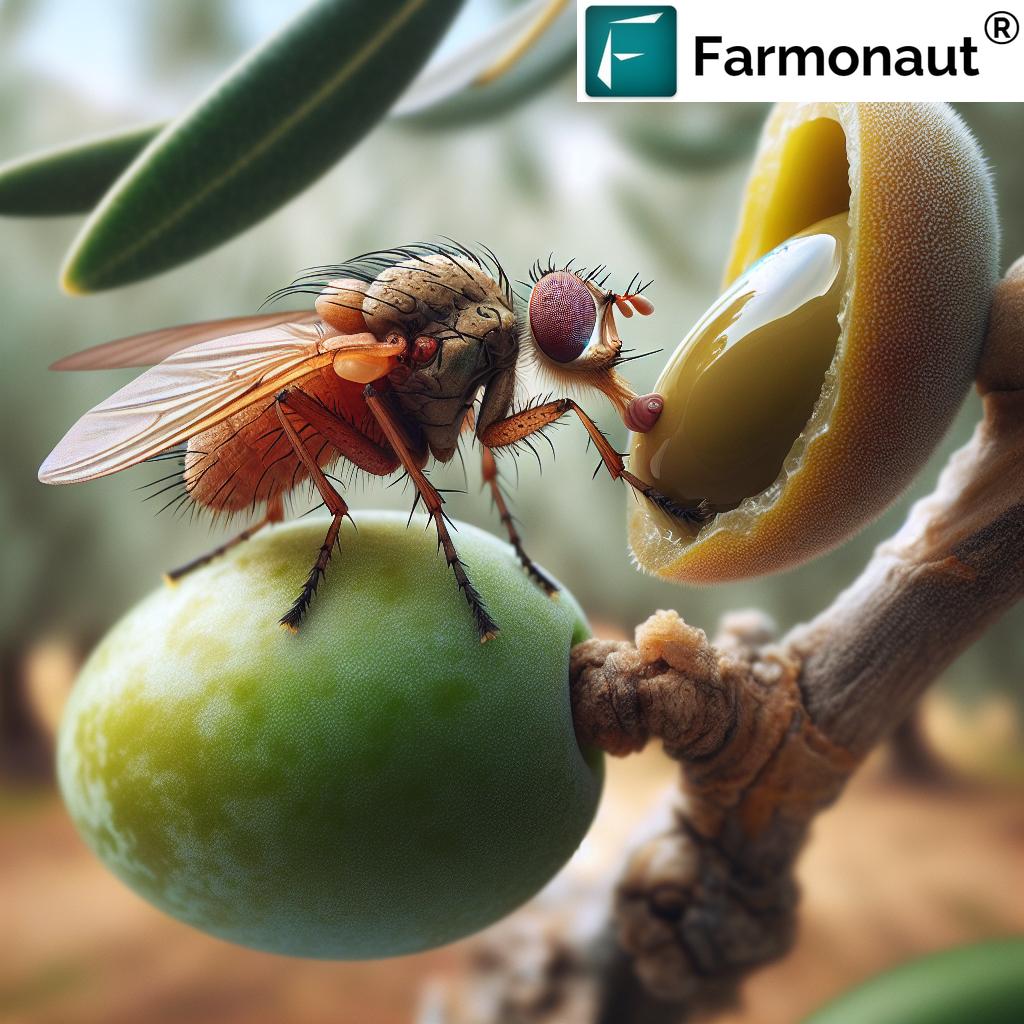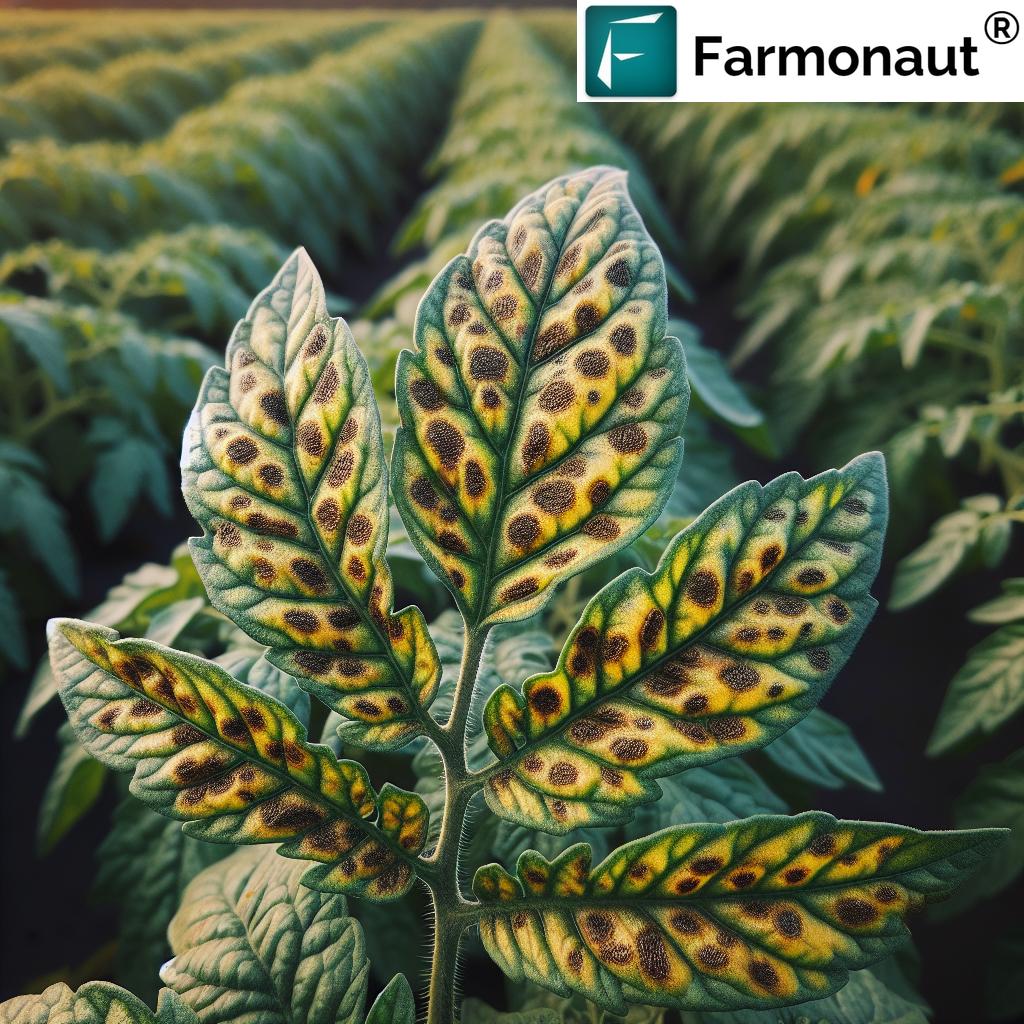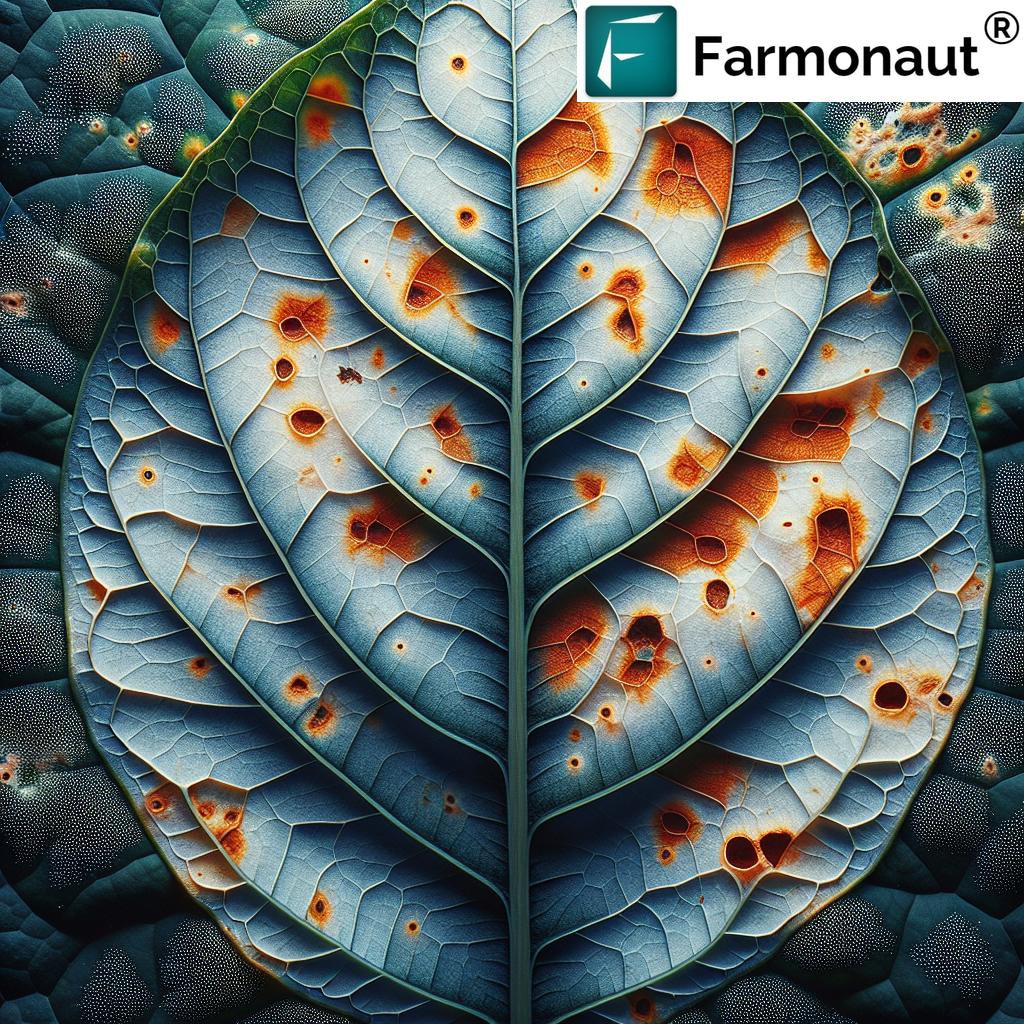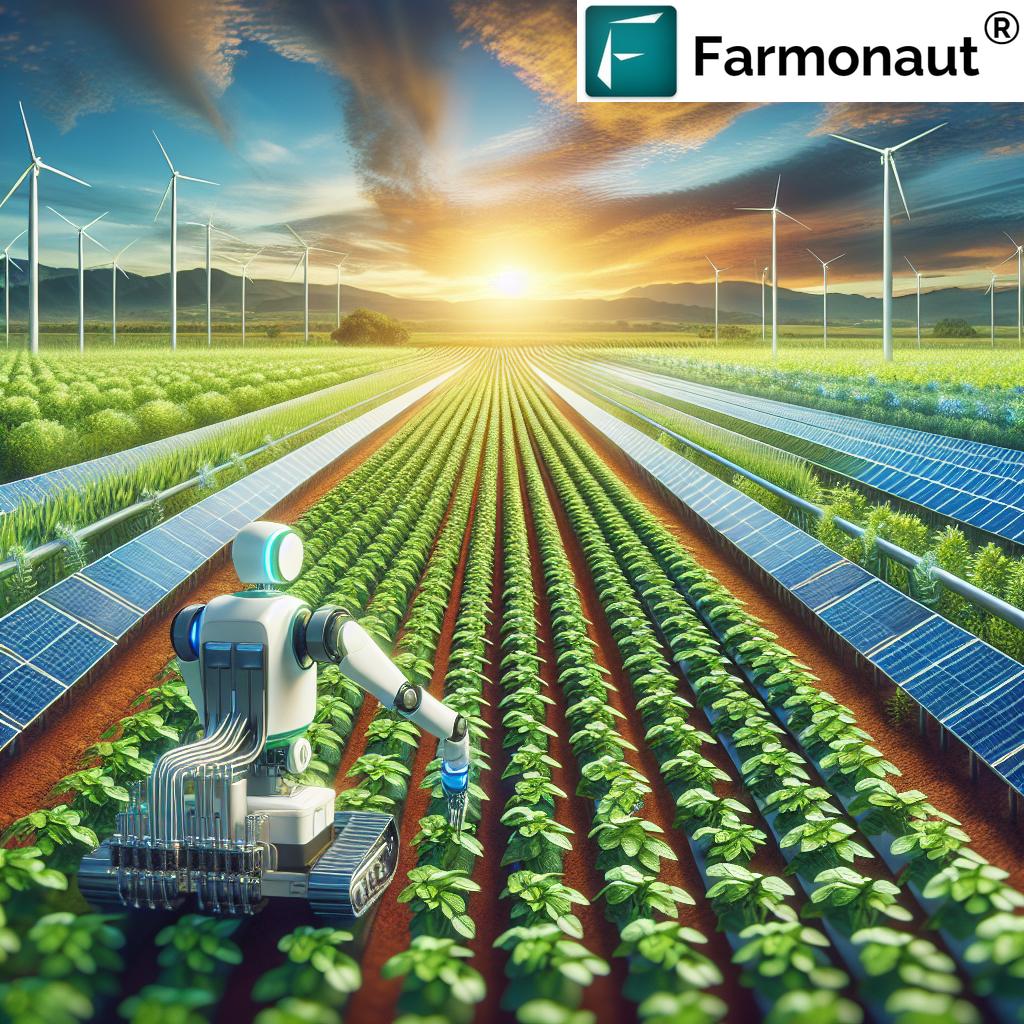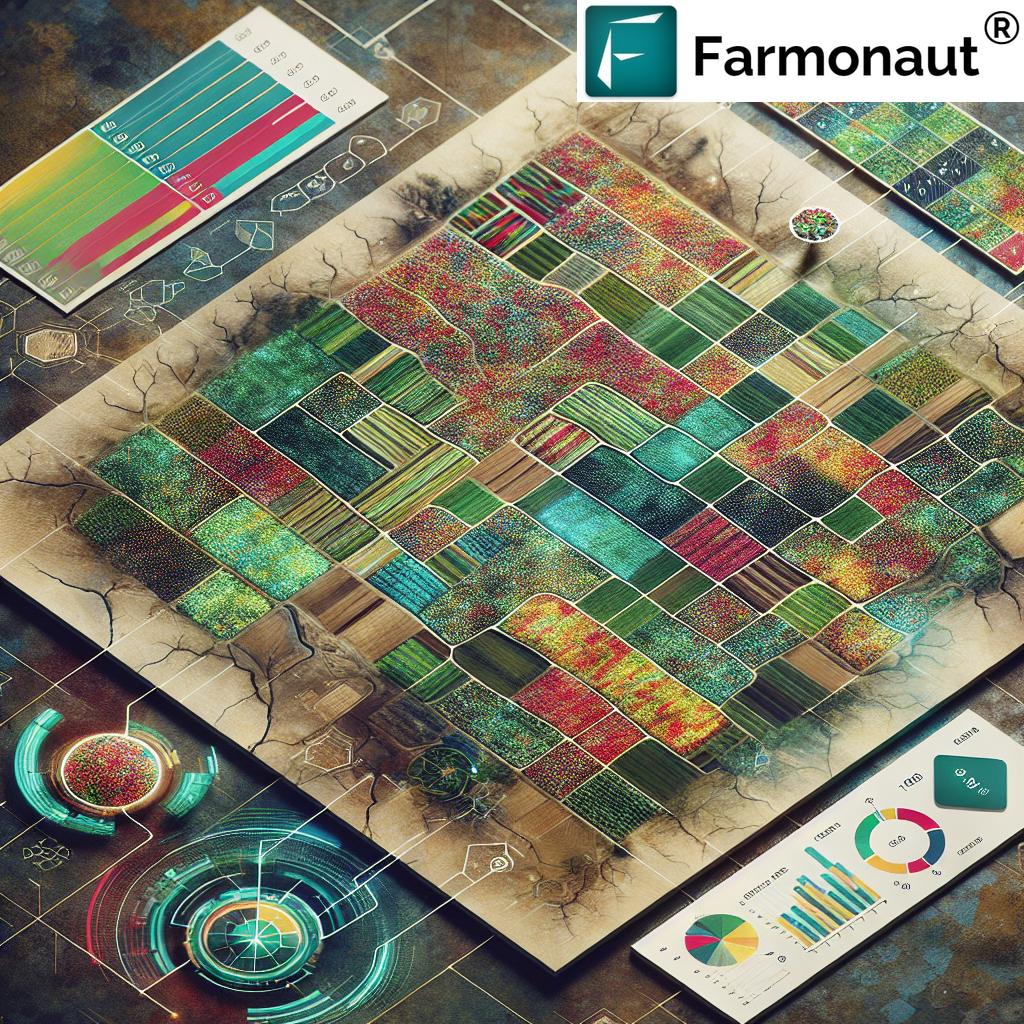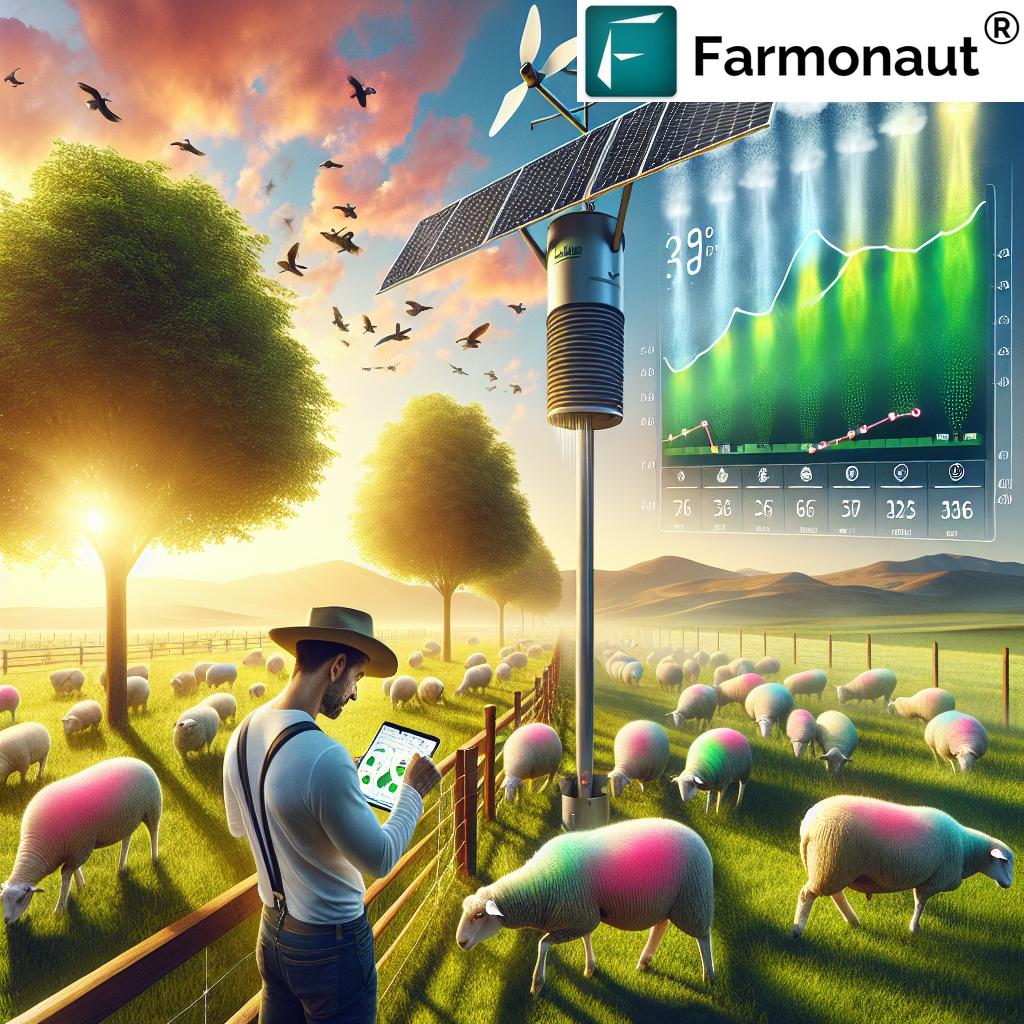IoT Agriculture: 7 Powerful Ways Smart Systems Boost Yields
“Smart irrigation systems can reduce water usage in agriculture by up to 30%, significantly improving resource efficiency.”
Table of Contents
- Introduction: The Digital Revolution in Agriculture
- What Is IoT in Agriculture? Transforming Farming with Smart Technologies
- 7 Powerful Ways IoT Agriculture Boosts Yields
- 1. Precision Farming Technologies: From Data to Decision-Making
- 2. Smart Irrigation Systems: Optimizing Every Drop
- 3. Crop Monitoring and Disease Detection: Proactive Crop Health
- 4. Livestock Monitoring Solutions: Smart Animal Management
- 5. Environmental Monitoring for Farms: Adapting to Nature in Real Time
- 6. Supply Chain Traceability in Agriculture: Ensuring Food Safety and Trust
- 7. Smart Greenhouses & Automated Fertilization: Controlled Growth and Resource Optimization
- Comparative Benefits Table of IoT Solutions in Agriculture
- Farmonaut: Making Precision Agriculture Accessible for All
- Key Benefits of IoT in Agriculture: Productivity, Resource Savings, and Sustainability
- How to Access Farmonaut: Web App, Mobile Apps, and API
- Farmonaut Subscription Model: Choose Your Plan
- Challenges and Considerations: Moving Towards Smarter Farming
- Frequently Asked Questions (FAQ)
- Conclusion: The Future of Sustainable, Data-Driven Agriculture
Introduction: The Digital Revolution in Agriculture
The dawn of the Internet of Things (IoT) in agriculture marks a transformative era for farming communities worldwide. By connecting devices, data, and individuals across vast landscapes, IoT enables us to turn traditional agriculture into a precise, efficient, and sustainable process. Through the integration of sensors, smart systems, and advanced analytics, farmers are empowered to make informed decisions that drive higher yields, reduce resource wastage, and promote sustainability.
Today, we are witnessing a fundamental shift—from guesswork and manual observation to real-time, data-driven management of crops, livestock, and the entire agricultural ecosystem. In this comprehensive guide, we explore how IoT applications are boosting farming productivity, enhancing food safety, and enabling a new level of efficiency in agricultural operations. We’ll also uncover how leading solutions like Farmonaut are democratizing these technologies for farmers everywhere.
What Is IoT in Agriculture? Transforming Farming with Smart Technologies
At its core, the Internet of Things (IoT) in agriculture refers to the integration of connected devices, sensors, and systems that collect, transmit, and analyze data concerning every aspect of farm operations. By connecting these technologies—from soil moisture sensors in the field to drones flying over crop canopies—we can intelligently manage resources, optimize yields, and protect crops against unpredictable challenges.
IoT-enabled farms utilize a rich network of hardware and software, including:
- Soil moisture, temperature, humidity, and nutrient sensors
- Weather stations and environmental monitors
- Smart irrigation and fertigation systems
- Drones and satellite monitoring for crop health and pest detection
- Wearable devices for livestock monitoring
- Data analytics and AI-driven decision tools
- Automated machinery and remote-controlled farm equipment
By integrating IoT into agriculture, we bridge the information gap that has long limited precision and scalability. The result? Smarter use of water, energy, and inputs; better crop quality and resilience; reduced environmental impact; and stronger traceability throughout the supply chain.
“IoT-based crop monitoring can increase farm yields by as much as 20% through real-time data-driven decisions.”
7 Powerful Ways IoT Agriculture Boosts Yields
Let’s dive into the transformative ways IoT in agriculture is reshaping farming. We’ll examine the key systems and applications driving higher efficiency, profitability, and sustainability.
1. Precision Farming Technologies: From Data to Decision-Making
Precision farming technologies are unlocking a wealth of opportunities for today’s farmers. By leveraging real-time data—from soil moisture to temperature and nutrient levels—we can make decisions that were once impossible, or based on broad assumptions. IoT sensors precisely monitor and map variations in soil, microclimate, and crop health across the field.
These data-driven insights facilitate:
- Optimized irrigation schedules and watering amounts, ensuring crops receive water when and where it’s needed.
- Tailored fertilization strategies that apply nutrients precisely, reducing waste and minimizing costs.
- Early detection of diseases, pests, and nutrient deficiencies via advanced detection systems.
- Improved crop yields through targeted interventions and smarter resource allocation.
- Reducing environmental footprint through optimized utilization of resources—leading to sustainable farming with IoT.
For example, Farmonaut’s platform employs satellite-based precision farming technologies to deliver real-time vegetation health (NDVI) data, soil moisture monitoring, and AI-assisted advisory. This level of information enables us to act rapidly and with surgical precision across farming operations.
Ready to integrate satellite-powered precision analytics into your operations? Farmonaut’s web app and mobile apps make precision farming accessible for every grower.
2. Smart Irrigation Systems: Optimizing Every Drop
Water management remains a critical challenge in agriculture. Excessive irrigation not only wastes water but can harm crops and deplete vital nutrients. Smart irrigation systems—powered by IoT sensors—automate watering schedules based on precise soil moisture, weather patterns, and crop requirements.
Benefits of IoT-powered smart irrigation include:
- Conserves water by applying only what crops need, when they need it.
- Prevents over- or under-watering, supporting optimal crop health and higher yields.
- Automates irrigation routines, freeing farmers from manual intervention.
- Integrates with weather forecasts and advanced analytics to predict upcoming needs.
Farmonaut’s advanced satellite-based soil moisture and weather monitoring systems deliver actionable insights for smart irrigation. By optimizing watering schedules, farmers can save up to 30% more water, reduce costs, and promote both efficiency and sustainability.
Further Reading: Farmonaut’s Plantation, Crop, and Forest Advisory Tools ensure every drop of water is put to the best use, combining remote sensing data with practical irrigation recommendations.
3. Crop Monitoring and Disease Detection: Proactive Crop Health
One of the most potent applications of IoT in agriculture is real-time crop monitoring and disease detection. Through a combination of drones, sensors, and satellite imagery, farmers can monitor crops over large areas to detect diseases, pest infestations, and nutrient deficiencies at the earliest stage.
The days of scouting every field on foot are over. Now, automated detection allows us to pinpoint problems and apply targeted interventions, such as:
- Dispatching drones for precision pesticide applications only where pest pressure is detected.
- Adjusting fertilization based on real-time detection of deficiency zones.
- Activating disease response protocols to minimize crop loss and halt outbreaks early.
Farmonaut’s AI-driven crop advisory leverages satellite and field sensor data to detect changes in crop vigor, predict risk patterns, and automate actionable alerts for users.
Learn More: Farmonaut Crop Monitoring Platform empowers growers to diagnose problems and optimize management—all from their phone or browser.
4. Livestock Monitoring Solutions: Smart Animal Management
The reach of IoT extends beyond crops. Livestock monitoring solutions employ wearable devices and animal behavior sensors to track health, location, and even reproductive status. These technologies help us detect illness early, optimize breeding programs, and reduce losses by automating alerts for abnormal animal activity.
Key advantages:
- Monitors remote herds 24/7, reducing labor and supporting rapid intervention.
- Improves animal welfare and productivity through better care and timely disease management.
- Integrates with farm management solutions for a holistic view of both crop and livestock operations.
With Farmonaut, fleet and resource management tools help large-scale agribusinesses and livestock operations monitor vehicles, equipment, and logistics, ensuring optimal herd and resource health.
5. Environmental Monitoring for Farms: Adapting to Nature in Real Time
Understanding and managing the environmental conditions of our fields is pivotal in today’s agriculture. With IoT sensors measuring everything from temperature and humidity to soil quality and atmospheric CO₂, environmental monitoring for farms enables us to adapt strategies dynamically, protect crops, and improve yield.
Applications of environmental monitoring include:
- Climate condition monitoring for accurate planting and harvesting schedules.
- Monitoring microclimates and field variability for tailored management.
- Ensuring compliance with environmental regulations and tracking carbon footprint.
Farmonaut’s carbon footprinting tools help agribusinesses measure emissions in real-time—vital for sustainability reporting and responsible resource management.
6. Supply Chain Traceability in Agriculture: Ensuring Food Safety and Trust
Modern agriculture thrives on transparency. Through supply chain traceability in agriculture enabled by IoT and blockchain, every step from the field to the consumer’s table is monitored and recorded. This guarantees food safety, reduces spoilage, and builds consumer trust.
Traceability solutions track:
- On-farm harvesting and post-harvest activities
- Storage and transport conditions (temperature, humidity, spoilage risks)
- Processing, packaging, and delivery routes
- End-to-end blockchain verification to prevent fraud
Farmonaut’s blockchain-based product traceability system integrates with farm data for complete, secure tracking—vital for meeting industry standards and strengthening brand reputation.
This use of IoT supports both the farmer and the consumer, delivering sustainable, transparent, and ethical supply chains.
7. Smart Greenhouses & Automated Fertilization: Controlled Growth and Resource Optimization
In smart greenhouses, IoT systems automate environmental controls—lighting, temperature, humidity, and ventilation—to ensure crops grow in optimal conditions year-round. By monitoring and reacting to real-time data, these greenhouses deliver higher yields with less energy, water, and manual intervention.
Paired with automated fertilization (fertigation) systems, farmers can apply fertilizers with pinpoint accuracy, maximizing nutrient uptake and minimizing runoff.
Key benefits include:
- Maintained optimal climate for sensitive or high-value crops
- Reduced labor needs and increased consistency of outcomes
- Significant resource and energy savings
- Higher profitability through yield optimization
Farmonaut’s platform supports greenhouse growers with AI-heavy analytics, sensor integration, and automated recommendations for all critical operations, from irrigation and fertilization to resource tracking.
Comparative Benefits Table of IoT Solutions in Agriculture
| IoT Application | Yield Improvement (Estimated %) | Resource Savings (Estimated %) | Technology Example | Sustainability Impact |
|---|---|---|---|---|
| Smart Irrigation Systems | 10–20% | Water savings of 20–30% | Soil moisture sensors; automated irrigation valves | Reduces water wastage and energy use |
| Crop Monitoring & Disease Detection | 15–20% | Input savings of 10–15% | Drone imaging; satellite crop health mapping | Minimizes pesticide use, reduces losses |
| Environmental Monitoring | 8–12% | Resource optimization up to 15% | Weather stations; soil and air sensors | Improves climate resilience, tracks emissions |
| Supply Chain Traceability | Quality improvement (recovery up to 18%) | Spoilage reduction up to 25% | Blockchain; storage condition devices | Strengthens food safety, reduces losses |
| Smart Greenhouses | 20–30% | Energy savings 15–20% | Automated HVAC, sensor-driven climate | Conserves resources, limits runoff |
| Livestock Monitoring | Production boost up to 12% | Feed and labor savings up to 10% | Wearable animal sensors; tracking collars | Reduces livestock sickness, improves welfare |
| Automated Fertilization | 10–15% | Fertilizer use savings 18–25% | Nutrient-level sensors; GPS variable rate tech | Limits chemical leaching and waste |
Farmonaut: Making Precision Agriculture Accessible for All
With the flood of advanced IoT technologies hitting the agricultural market, accessibility and cost-effectiveness remain key hurdles for many. This is where Farmonaut stands out—as a leader in making precision agriculture practical for everyone, from smallholder farmers to large-scale agribusinesses.
Here’s how Farmonaut addresses the modern challenges of IoT in agriculture:
- Satellite-Based Crop Health Monitoring: Multispectral satellite data helps track vegetation health (NDVI), soil moisture levels, and weather risks across vast territories without costly field hardware.
- AI-Powered Jeevn Farm Advisory: Real-time weather updates, actionable advice, and predictive analytics inform every management decision.
- Blockchain-Based Product Traceability: Supply chain transparency and food safety—from seed to shelf—is streamlined and verifiable via secure, digital records.
- Fleet and Resource Management: Keep equipment, fleets, and resources optimized for cost savings and improved safety.
- Carbon Footprinting: Support compliance, sustainability reporting, and impact reduction with real-time emissions data.
Farmonaut’s large-scale farm management platform brings these state-of-the-art solutions to plantations, estates, and government agencies, offering a scalable approach to the most complex agricultural needs.
Looking to integrate IoT data directly into your proprietary solutions? Farmonaut API access and developer documentation make it easy to merge satellite and weather stats into any digital platform.
Key Benefits of IoT in Agriculture: Productivity, Resource Savings, and Sustainability
- Enhanced Productivity and Efficiency: Early detection of issues like pests, diseases, and deficiencies means less crop loss and higher yields. Automated processes eliminate guesswork and boost quality.
- Cost Reduction and Profitability: Optimized resource utilization leads to lower costs—whether through smarter irrigation, reduced pesticide and fertilizer use, or streamlined operations.
- Sustainable Farming with IoT: Environmental monitoring and precision interventions limit pollution, conserve water, and protect biodiversity.
- Informed Decision Making: Data analytics and predictive modeling empower growers to plan more effectively, capitalize on market opportunities, and minimize risks.
- Transparency and Food Safety: Full traceability across the supply chain means safer food, less spoilage, and stronger consumer trust.
- Scalability and Accessibility: From a single hectare to national monitoring programs, scalable platforms like Farmonaut put advanced technologies in every farmer’s hands.
Explore Farmonaut’s crop loan & insurance verification tools, which use satellite data for secure, fraud-resistant financing.
How to Access Farmonaut: Web App, Mobile Apps, and API
Our mission is to make data-driven, sustainable agriculture accessible to all. Here are several ways to get started:
- Farmonaut Web App: Access advanced satellite, weather, and advisory services from your desktop or browser—no installation required.
- Farmonaut Android App: Free download on Google Play for on-the-go farm management, crop health tracking, and weather monitoring.
- Farmonaut iOS App: Available on the App Store for seamless iPhone & iPad usage—field management, alerts, and insights in your pocket.
- Farmonaut API: Directly integrate crop/field data into your own platforms via our versatile API. (Developer Docs).
Farmonaut Subscription Model: Choose Your Plan
Farmonaut operates on a flexible, subscription-based model suited for individual growers, cooperatives, agribusinesses, and institutions. Simply select your plan based on area monitored, data frequency, and service needs—scaling as your operation grows. Enjoy the benefits of real-time, advanced analytics, precision monitoring, blockchain traceability, and more, at a fraction of the traditional cost.
Challenges and Considerations: Moving Towards Smarter Farming
While the possibilities are vast, adopting IoT in agriculture does come with its own challenges:
- Initial Technology Costs: While solutions like Farmonaut lower the barrier by using satellites over field devices, budget remains a consideration—evaluate ROI against immediate gains and long-term benefits.
- Data Security: Protecting farm data and supply chain transparency in a connected world requires robust digital safeguards.
- Technical Expertise: A learning curve exists for navigating new systems. Platforms focused on usability and support are key to smooth adoption.
- Infrastructure Reliability: Reliable network and sensor infrastructure are critical in rural or remote areas—select providers with robust connectivity tools.
- Integration: Aligning new smart systems with existing farm workflows can take planning—choose modular, scalable solutions.
Despite these, the balance of potential benefits—from resource savings to regulatory compliance and climate resilience—make the move to IoT-enabled agriculture a compelling step for future-focused growers and agri-leaders.
Frequently Asked Questions (FAQ)
What is IoT in agriculture?
IoT in agriculture involves connecting sensors, devices, and systems across farms to collect, analyze, and act on data. It transforms traditional farming into a smart, data-driven process, enhancing yields, efficiency, and sustainability.
How do smart irrigation systems work?
Smart irrigation systems use soil moisture sensors and weather data to automatically adjust watering schedules. They ensure crops receive the right amount of water, reducing waste and boosting crop health.
What are the main benefits of precision farming technologies?
Precision farming technologies optimize resource use, reduce input costs, increase yields, and minimize environmental impact by using real-time field and crop data for tailored interventions.
How does crop monitoring and disease detection improve yields?
By providing early alerts on diseases, pests, and deficiencies, these systems enable timely, targeted interventions that reduce crop loss and maximize productivity.
Can IoT help reduce the environmental impact of farming?
Yes. By optimizing water and input use, minimizing chemical leaching, and tracking carbon footprints, IoT systems help farmers adopt sustainable practices and reduce their environmental impact.
Is supply chain traceability with IoT important?
Absolutely. It enhances food safety, prevents spoilage, ensures quality, and builds consumer trust by offering full transparency from farm to table.
How can I start using Farmonaut’s precision agriculture services?
Simply sign up on the Farmonaut web or mobile app, select your subscription, and begin integrating cutting-edge satellite and AI-powered insights into your farm.
Who can benefit from Farmonaut’s platform?
Individual farmers, cooperatives, agribusinesses, government agencies, research organizations, and food companies—anyone invested in smart, sustainable agriculture can benefit.
Conclusion: The Future of Sustainable, Data-Driven Agriculture
The integration of IoT in agriculture has set the stage for a revolution—one where every field, every crop, and every resource is managed with precision, intelligence, and foresight. Through the power of connected systems, sensors, and analytics, we are unlocking new potential for productivity, sustainability, and profitability across the entire agricultural value chain.
Smart irrigation and fertigation, advanced crop monitoring, animal and environmental tracking, blockchain-based supply chain solutions—these tools aren’t just futuristic concepts; they are redefining what it means to farm, produce food, and protect our environment today. Companies like Farmonaut are democratizing precision farming technologies, breaking cost and access barriers for farmers of every scale.
As we look to the future, our task is clear: continue to embrace innovation, prioritize sustainability, and use every tool at our disposal to feed a growing world—responsibly, efficiently, and transparently. The promise of IoT is not just in higher yields, but in a better future for agriculture.
Ready to transform your farm with IoT? Start your Farmonaut journey today!


